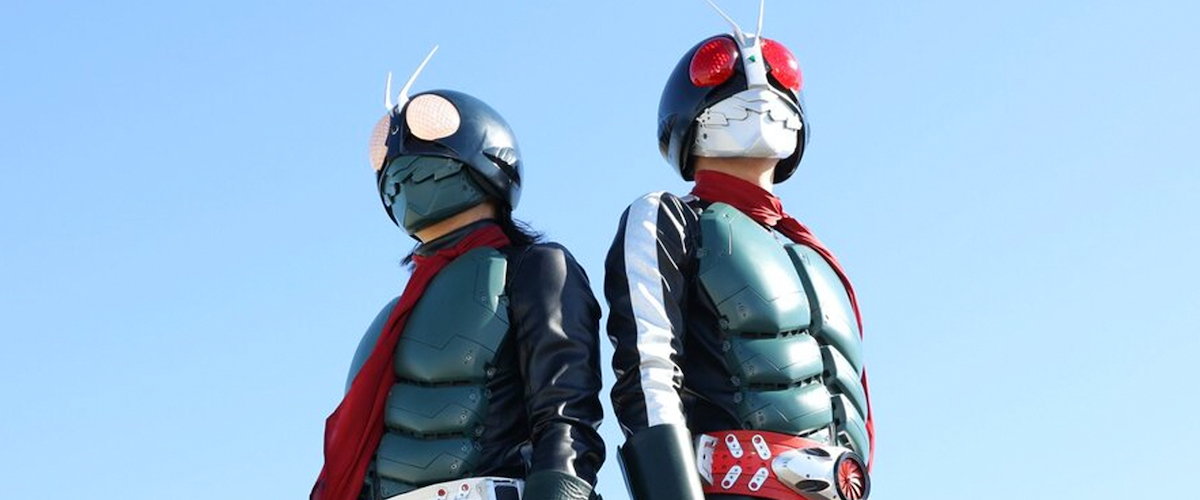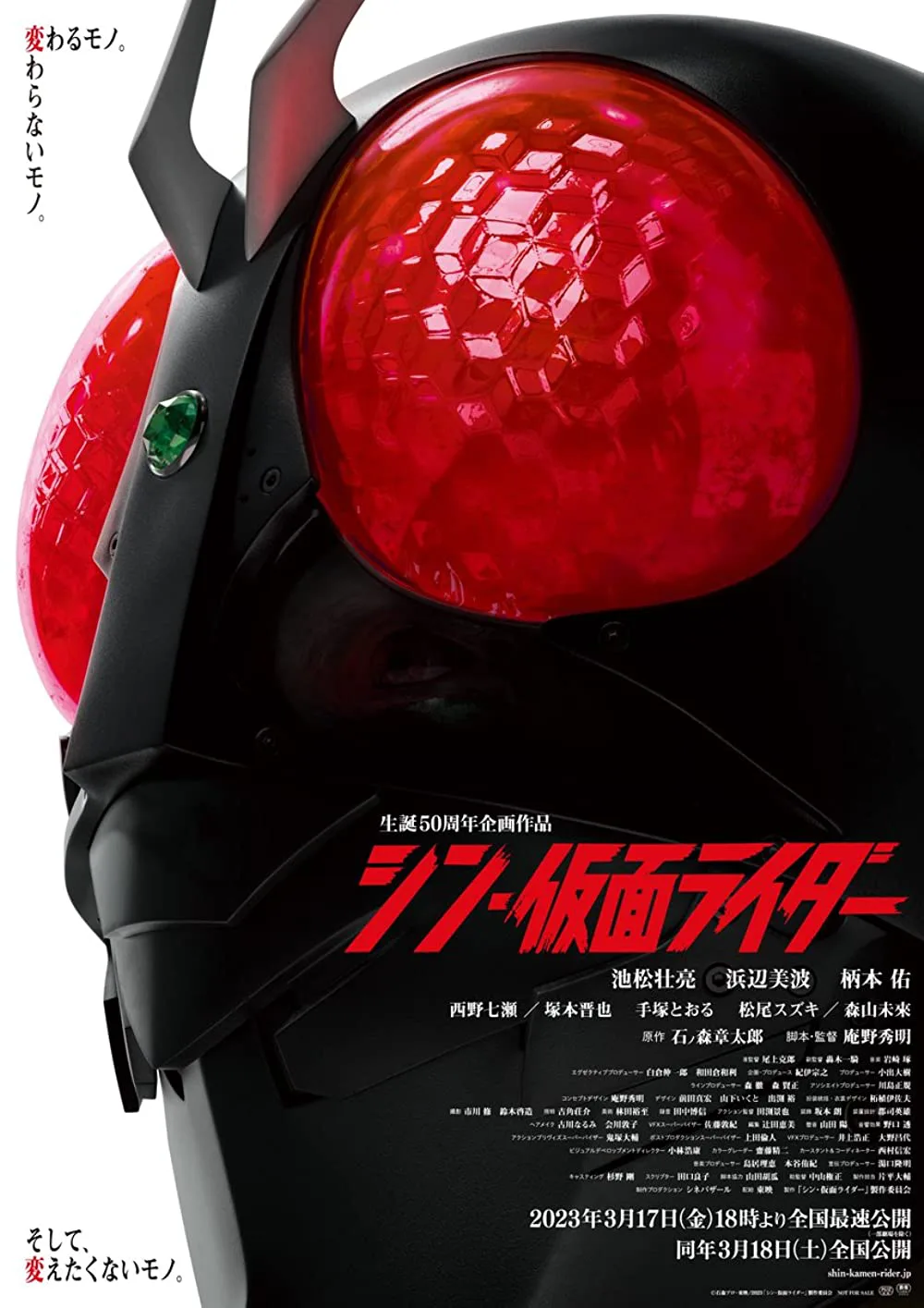It takes a moment for the Japanese superhero adventure “Shin Kamen Rider” to find a rhythm and stick to it. Writer/director Hideaki Anno (“Neon Genesis Evangelion”) throws a lot at viewers during the movie’s preliminary half hour or so, but it all reflects the optimistic character of motorcyclist hero Takeshi Hongo (Sosuke Ikematsu), who transforms into the grasshopper-themed robot biker Kamen Rider.
There’s also the movie’s poorly-rendered special effects, glassy-looking handheld photography, hard cuts, and off-kilter camera blocking. Most of these choices are deliberate, just like in both “Shin Godzilla” and “Shin Ultraman,” which Anno co-created with director/co-writer/special-effects supervisor Shinji Higuchi. “Shin Kamen Rider” looks like the cheapest (to make) of the three movies, so this much unusual style might initially seem more like a bug than a feature. Eventually, this outstanding reboot’s most generic elements appear subordinate to the title character’s deranged, boyish, and sometimes romantic subjective reality.
Anno’s take on Kamen Rider plays out like a loving, idiosyncratic deconstruction of Kamen Rider, a wayward young hero who defends the world from the villainous SHOCKER organization and their various animal-men cyborgs. In “Shin Kamen Rider,” Hongo sets out on his anti-SHOCKER crusade after he reluctantly (and gruesomely) beats up a group of beret-clad SHOCKER heavies and a spider-robot (Nao Omori), too.
Hongo is then debriefed by icy monster-hunter Ruriko (Minami Hamabe) and her dad, Dr. Midorikawa (“Tetsuo: The Iron Man” director Shinya Tsukamoto), a disenchanted robot-building scientist. Basically, Dr. Midorikawa used to make insect-men for SHOCKER, but then turned against them, and also experimented on Hongo to give him the super-powers needed to defeat SHOCKER. Dr. Midorikawa dies pretty early on; he’s the first of a few characters who, when they croak, dissolves into a man-shaped silhouette of seafoam bubbles. After he melts away into nothingness, Ruriko and Hongo set out on their journey to destroy SHOCKER, with some help from a pair of mysterious government agents, Taki and Tachibana (Takumi Saitoh and Yutaka Takenouchi).
A good part of “Shin Kamen Rider” concerns Hongo’s struggle to serve others without betraying his conscience. He struggles with his computer-programmed survival instincts, which tend to be brutal. But each new insect-themed adversary re-orients both Ruriko and Hongo’s relationship to their shared mission so that it’s a more personal fight: the final boss antagonist is ultimately Ruriko’s megalomaniacal brother Ichiro (Mirai Moriyama), a butterfly-monster and the leader of SHOCKER.
Anno also frustrates and re-orients the viewers’ relationship with what were always childishly simple characters. He periodically shoves his camera into actors’ faces or beneath their legs, cuts just ahead of the action, and blows up several key images so that any featured actor’s face is more prominent than their characters’ bright and garish outfits. This potentially off-putting style still effectively dramatizes Hongo and his allies’ adrenaline-fueled disorientation. Anno also catches viewers up as we go, slowing down the action and the dramatic momentum just enough to make even a fight with a half-praying-mantis, half-chameleon monster (Kanata Hongo) seem affecting.
Some viewers might be distracted by the movie’s stop-and-go pacing, unsophisticated action choreography, and unglamorous, low-resolution special effects. Maybe, but so what? Anno’s take resonates because it shares the experimental spirit and naïve angst—Who am I, and how do I hold onto myself in a group united by a common goal?—both prior “Shin” reboots and both Anno’s original “Neon Genesis Evangelion” series and its recent “Rebuild” remakes of that oft-copied anime. Many people will come to “Shin Kamen Rider” expecting a movie by Hideaki Anno; they won’t be disappointed.
Action fans will have to make like Hongo and re-orient how they see a buggy bike-riding superhero whose main power source remains a pinwheel-activated belt buckle. Thankfully, Anno’s deep love and understanding for the Kamen Rider characters never devolves into Xerox-faithful reverence. The concluding half hour or so of “Shin Kamen Rider” also pulls everything together in such a smooth and impressive way that it miraculously recasts the movie’s bumpy opening in a softer light. Even the action scenes appreciate as extensions of Anno and his characters’ quest to re-imagine their roles as action heroes in a heavily automated world.
Anno’s fingerprints stand out, given how mindlessly literal and/or timid many contemporary American superhero movies tend to be. “Shin Kamen Rider” remains thrilling and thoughtful, both as an expression of Anno’s instantly recognizable style and a weirdly moving expression of the title hero’s restless spirit. You might not believe that you could be so moved by a superhero movie about a grasshopper-man on a bike. You would be wrong.
Now playing in theaters.




















